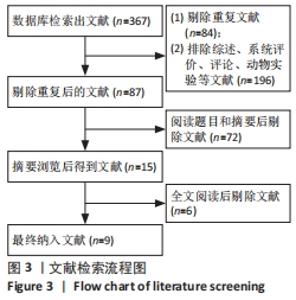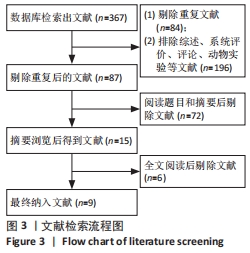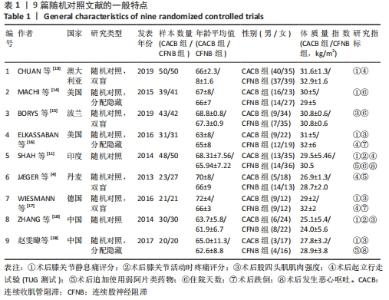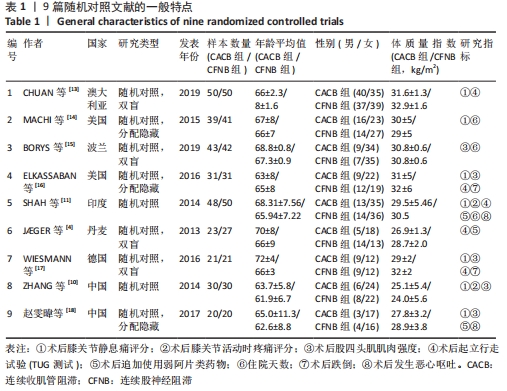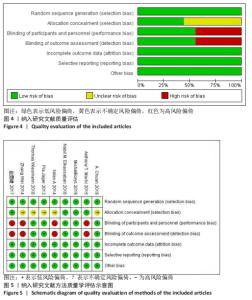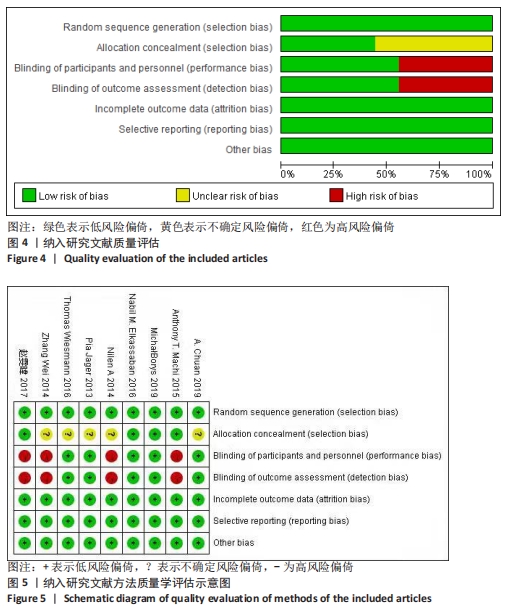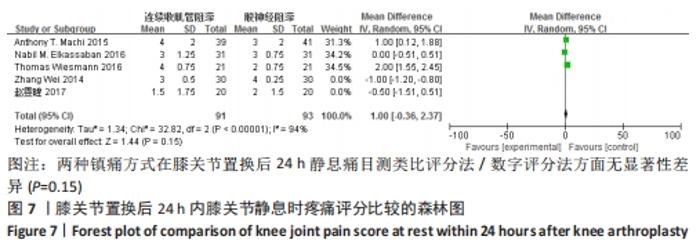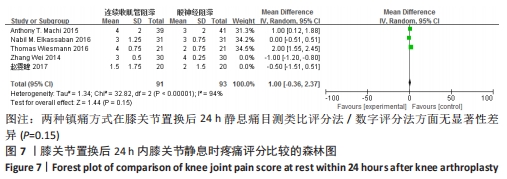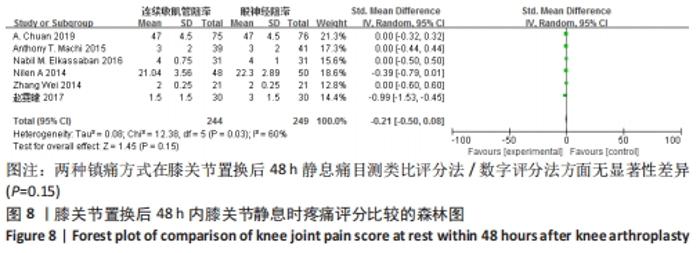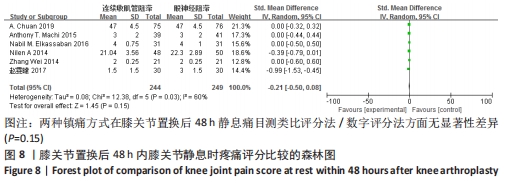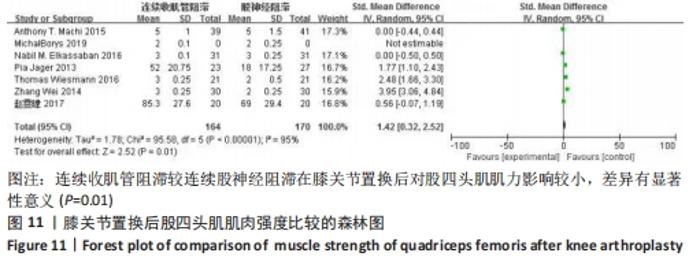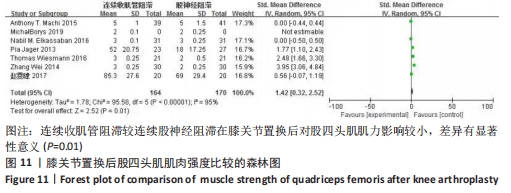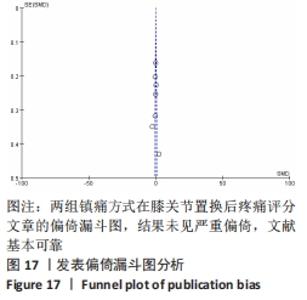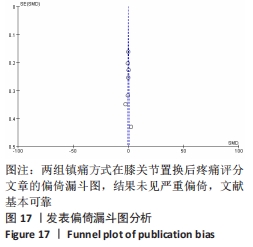Chinese Journal of Tissue Engineering Research ›› 2023, Vol. 27 ›› Issue (4): 640-645.doi: 10.12307/2022.960
Previous Articles Next Articles
A meta-analysis of the effects of continuous adductor canal block and continuous femoral nerve block on early activity after knee arthroplasty
Xu Yangyang1, He Peiliang2, Meng Qingqi2, Li Siming1, 2
- 1Guizhou Medical University, Guiyang 550025, Guizhou Province, China; 2Guangzhou Red Cross Hospital, Jinan University, Guangzhou 510220, Guangdong Province, China
-
Received:2021-11-26Accepted:2022-01-22Online:2023-02-08Published:2022-06-23 -
Contact:Li Siming, MD, Chief physician, Doctoral supervisor, Guizhou Medical University, Guiyang 550025, Guizhou Province, China; Guangzhou Red Cross Hospital, Jinan University, Guangzhou 510220, Guangdong Province, China -
About author:Xu Yangyang, Master candidate, Physician, Guizhou Medical University, Guiyang 550025, Guizhou Province, China
CLC Number:
Cite this article
Xu Yangyang, He Peiliang, Meng Qingqi, Li Siming. A meta-analysis of the effects of continuous adductor canal block and continuous femoral nerve block on early activity after knee arthroplasty[J]. Chinese Journal of Tissue Engineering Research, 2023, 27(4): 640-645.
share this article
Add to citation manager EndNote|Reference Manager|ProCite|BibTeX|RefWorks
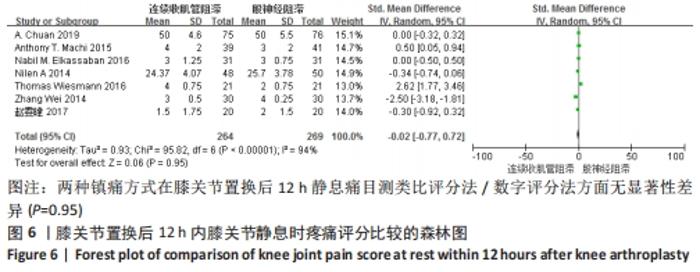
2.2 Meta分析结果 2.2.1 膝关节置换后疼痛评分 (1)关节置换后膝关节静息痛目测类比评分法/数字评分法得分:因为目测类比评分法和数字评分法是2个类似的疼痛评分系统,所以作者将这些系统的评分合并为一个结果进行分析。7项文献研究报告了533例膝关节置换后12 h内的疼痛评分[10-11,13-14,16-18],各研究有显著异质性 (P < 0.000 01,I2=94%),采用随机效应模型分析数据显示两组之间无显著差异(MD=-0.02;95%CI:-0.77-0.72;P=0.95),见图6。5项研究评估184例膝关节置换后24 h内的疼痛评分[10,14,16-18],各研究之间有显著异质性(P < 0.000 01,I2=94%),采用随机效应模式行Meta分析,数据显示两组之间无显著差异(MD=1.00;95%CI: -0.36-2.37;P=0.15),见图7。6项研究报告了493例膝关节置换后48 h的疼痛评分[10-11,13-14,16,18],各研究之间有较大异质性(P=0.03,I2=60%),采用随机效应模式行Meta分析,数据显示两组之间无显著差异(MD=-0.21;95%CI:-0.50-0.08;P=0.15),见图8。 "
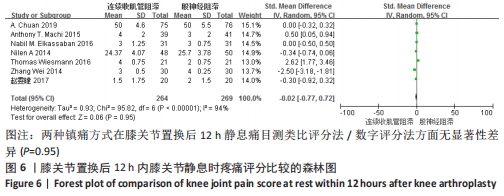
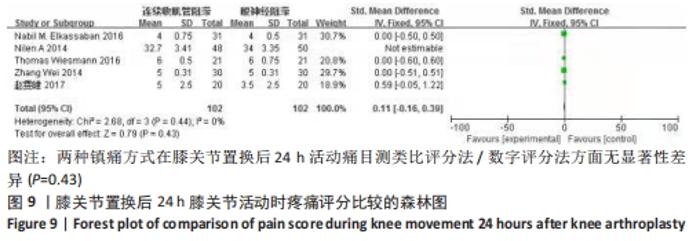
(2) 关节置换后膝关节活动痛目测类比评分法/数字评分法评分:5项文献报告了204例全膝关节置换后24 h内活动时疼痛评分[10-11,16-18],各研究之间无异质性(P=0.44,I2=0%),采用固定效应模式行Meta分析,数据显示两组之间无显著差异(MD=0.11;95%CI:-0.16-0.39;P=0.43),见图9。有4项文献报告了260例全膝关节置换后48 h活动时疼痛评分[10-11,16,18],各研究之间没有异质性(P=0.57,I2=0%),采用固定效应模式行Meta分析,数据显示两组之间无显著差异(MD=-0.14;95%CI:-0.38-0.11;P= 0.28),见图10。 "
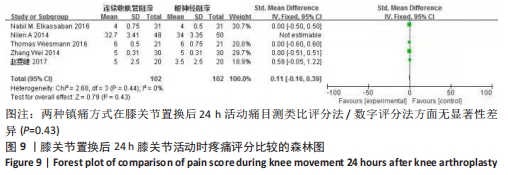
| [1] CRAM P, LU X, KATES SL, et al. Total knee arthroplasty volume, utilization, and outcomes among Medicare beneficiaries, 1991-2010. JAMA. 2012;308(12):1227-1236. [2] ANDERSEN LØ, GAARN-LARSEN L, KRISTENSEN BB, et al. Subacute pain and function after fast-track hip and knee arthroplasty. Anaesthesia. 2009;64(5):508-513. [3] GAO F, MA J, SUN W, et al. Adductor Canal Block Versus Femoral Nerve Block for Analgesia After Total Knee Arthroplasty: A Systematic Review and Meta-analysis. Clin J Pain. 2017; 33(4):356-368. [4] JÆGER P, ZARIC D, FOMSGAARD JS, et al.Adductor canal block versus femoral nerve block for analgesia after total knee arthroplasty: a randomized, double-blind study. Reg Anesth Pain Med. 2013;38(6):526-532. [5] HANSON NA, ALLEN CJ, HOSTETTER LS, et al. Continuous ultrasound-guided adductor canal block for total knee arthroplasty: a randomized, double-blind trial. Anesth Analg. 2014;118(6):1370-1377. [6] LI D, YANG Z, XIE X, et al. Adductor canal block provides better performance after total knee arthroplasty compared with femoral nerve block: a systematic review and meta-analysis. Int Orthop. 2016;40(5):925-933. [7] ZHAO XQ, JIANG N, YUAN FF, et al. The comparison of adductor canal block with femoral nerve block following total knee arthroplasty: a systematic review with meta-analysis. J Anesth. 2016;30(5):745-754. [8] MEMTSOUDIS SG, YOO D, STUNDNER O, et al. Subsartorial adductor canal vs femoral nerve block for analgesia after total knee replacement. Int Orthop. 2015;39(4):673-680. [9] GREVSTAD U, MATHIESEN O, VALENTINER LS, et al. Effect of adductor canal block versus femoral nerve block on quadriceps strength, mobilization, and pain after total knee arthroplasty: a randomized, blinded study. Reg Anesth Pain Med. 2015;40(1):3-10. [10] ZHANG W, HU Y, TAO Y, et al. Ultrasound-guided continuous adductor canal block for analgesia after total knee replacement. Chin Med J (Engl). 2014;127(23):4077-4081. [11] SHAH NA, JAIN NP. Is continuous adductor canal block better than continuous femoral nerve block after total knee arthroplasty? Effect on ambulation ability, early functional recovery and pain control: a randomized controlled trial. J Arthroplasty. 2014;29(11):2224-2229. [12] KIM DH, LIN Y, GOYTIZOLO EA, et al. Adductor canal block versus femoral nerve block for total knee arthroplasty: a prospective, randomized, controlled trial. Anesthesiology. 2014;120(3):540-550. [13] CHUAN A, LANSDOWN A, BRICK KL, et al. Adductor canal versus femoral triangle anatomical locations for continuous catheter analgesia after total knee arthroplasty: a multicentre randomised controlled study. Br J Anaesth. 2019;123(3):360-367. [14] MACHI AT, SZTAIN JF, KORMYLO NJ, et al. Discharge Readiness after Tricompartment Knee Arthroplasty: Adductor Canal versus Femoral Continuous Nerve Blocks-A Dual-center, Randomized Trial. Anesthesiology. 2015;123(2):444-456. [15] BORYS M, DOMAGAŁA M, WENCŁAW K, et al. Continuous femoral nerve block is more effective than continuous adductor canal block for treating pain after total knee arthroplasty: A randomized, double-blind, controlled trial. Medicine (Baltimore). 2019;98(39):e17358. [16] ELKASSABANY NM, ANTOSH S, AHMED M, et al. The Risk of Falls After Total Knee Arthroplasty with the Use of a Femoral Nerve Block Versus an Adductor Canal Block: A Double-Blinded Randomized Controlled Study. Anesth Analg. 2016;122(5):1696-1703. [17] WIESMANN T, PIECHOWIAK K, DUDERSTADT S, et al. Continuous adductor canal block versus continuous femoral nerve block after total knee arthroplasty for mobilisation capability and pain treatment: a randomised and blinded clinical trial. Arch Orthop Trauma Surg. 2016; 136(3):397-406. [18] 赵旻暐,王宁,曾琳,等.膝关节置换术后连续收肌管阻滞与股神经阻滞的疗效比较[J].北京大学学报(医学版),2017,49(1):142-147. [19] KARLSEN AP, WETTERSLEV M, HANSEN SE, et al. Postoperative pain treatment after total knee arthroplasty: A systematic review. PLoS One. 2017;12(3):e0173107. [20] LI S, ZHOU J, LI X, et al. Analgesic Impact of Single-Shot Versus Continuous Femoral Nerve Block After Total Knee Arthroplasty: A Systematic Review and Meta-Analysis. Adv Ther. 2020;37(2):671-685. [21] ANGERS M, BELZILE ÉL, VACHON J, et al. Negative Influence of femoral nerve block on quadriceps strength recovery following total knee replacement: A prospective randomized trial. Orthop Traumatol Surg Res. 2019;105(4):633-637. [22] BOLARINWA SA, NOVICOFF W, CUI Q. Reducing costly falls after total knee arthroplasty. World J Orthop. 2018;9(10):198-202. [23] TURBITT LR, MCHARDY PG, CASANOVA M, et al. Analysis of Inpatient Falls After Total Knee Arthroplasty in Patients With Continuous Femoral Nerve Block. Anesth Analg. 2018; 127(1):224-227. [24] KUANG MJ, MA JX, FU L, et al. Is Adductor Canal Block Better Than Femoral Nerve Block in Primary Total Knee Arthroplasty? A GRADE Analysis of the Evidence Through a Systematic Review and Meta-Analysis. J Arthroplasty. 2017;32(10):3238-3248.e3. |
| [1] | Li Yaping, Liu Hong, Gao Zhen, Chen Xiaolin, Huang Wujie, Jiang Zheng. Three-dimensional motion analysis of lower limb biomechanical performance in Tai Chi practitioners accompanied by knee joint pain [J]. Chinese Journal of Tissue Engineering Research, 2023, 27(4): 520-526. |
| [2] | Wei Bo, Yao Qingqiang, Tang Cheng, Li Xuxiang, Xu Yan, Wang Liming. Advantage of medial pivot prosthesis in total knee arthroplasty via medial subvastus approach [J]. Chinese Journal of Tissue Engineering Research, 2023, 27(4): 552-557. |
| [3] | Wan Guoli, Shi Chenhui, Wang Weishan, Li Ang, Shi Xunda, Cai Yi. Retrospective analysis of the influencing factors of chronic pain after total knee arthroplasty [J]. Chinese Journal of Tissue Engineering Research, 2023, 27(4): 558-564. |
| [4] | Gu Mingxi, Wang Bo, Tian Fengde, An Ning, Hao Ruihu, Wang Changcheng, Guo Lin. Comparison of early efficacy and safety of simultaneous and staged bilateral total knee arthroplasty [J]. Chinese Journal of Tissue Engineering Research, 2023, 27(4): 565-571. |
| [5] | Zhang Jinbiao, Li Xiaoming, Xing Wanlin, Ma Fei, Yu Qiaoya, Dai Rongqin. Early warning efficacy of thrombus molecular markers after total knee arthroplasty in patients complicated with venous thromboembolism [J]. Chinese Journal of Tissue Engineering Research, 2023, 27(4): 572-577. |
| [6] | Xu Xiangjun, Wang Chao, Song Qunshan, Li Bingyan, Zhang Jichao, Wang Guodong, Dong Yuefu. Optimal angle for prosthesis implantation in total knee arthroplasty [J]. Chinese Journal of Tissue Engineering Research, 2023, 27(4): 612-618. |
| [7] | Yu Jiaan, Liu Xinwei, Lian Hongyu, Liu Kexin, Li Zitao. Medial open-wedge tibial osteotomy versus lateral closed-wedge tibial osteotomy for unicompartmental knee osteoarthritis: a meta-analysis [J]. Chinese Journal of Tissue Engineering Research, 2023, 27(4): 632-639. |
| [8] | Chai Hao, Yang Deyong, Zhang Lei, Shu Li. 3D printing personalized osteotomy guide technology versus conventional total knee arthroplasty on the accuracy of lower limb force alignment: a meta-analysis [J]. Chinese Journal of Tissue Engineering Research, 2023, 27(4): 646-654. |
| [9] | You Aijia, Li Wenjie, Zhou Junli, Li Chun. Systematic evaluation of six dressings on wound safety following total hip and knee arthroplasty [J]. Chinese Journal of Tissue Engineering Research, 2023, 27(3): 486-492. |
| [10] | Zhao Feng, Fan Shaoqing, Cheng Xiaoyan, Li Xiaona, Li Changsheng, Ma Haojie. miR-132-3p targets and modulates Ptch1 to reduce neuropathic pain in mice with chronic constriction injury [J]. Chinese Journal of Tissue Engineering Research, 2023, 27(2): 230-236. |
| [11] | Hu Fei, Wang Jie. Safety and efficacy of mesenchymal stem cells in the treatment of ischemic stroke: a meta-analysis [J]. Chinese Journal of Tissue Engineering Research, 2023, 27(1): 76-82. |
| [12] | Jing Jinpeng, Zhang Yue, Liu Xiaomin, Liu Yi. Traditional Chinese medicine injection for promoting blood circulation in prevention of deep vein thrombosis after orthopedic surgery: network meta-analysis [J]. Chinese Journal of Tissue Engineering Research, 2022, 26(9): 1467-1476. |
| [13] | Kan Houming, Fan Lijun, Chen Xuetai, Shen Wen. Application of platelet-rich plasma in neuropathic pain [J]. Chinese Journal of Tissue Engineering Research, 2022, 26(8): 1286-1292. |
| [14] | Liu Gang, Ma Chao, Wang Le, Zeng Jie, Jiao Yong, Zhao Yi, Ren Jingpei, Hu Chuanyu, Xu Lin, Mu Xiaohong. Ankle-foot orthoses improve motor function of children with cerebral palsy: a Meta-analysis based on 12 randomized controlled trials [J]. Chinese Journal of Tissue Engineering Research, 2022, 26(8): 1299-1304. |
| [15] | Huang Hao, Hong Song, Wa Qingde. Finite element analysis of the effect of femoral component rotation on patellofemoral joint contact pressure in total knee arthroplasty [J]. Chinese Journal of Tissue Engineering Research, 2022, 26(6): 848-852. |
| Viewed | ||||||
|
Full text |
|
|||||
|
Abstract |
|
|||||
